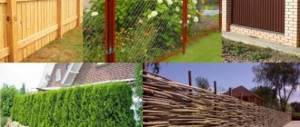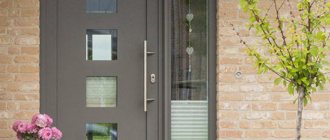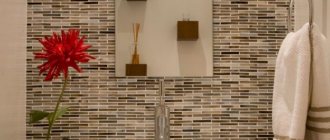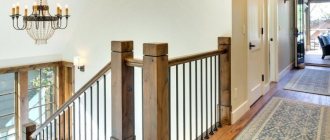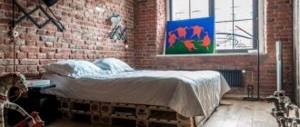After people learned how to properly process metal, new opportunities opened up to improve human comfort and quality of life. It has become possible to use the forging method to produce beautiful and practical products that do not lose their relevance today. This material has proven itself to be an excellent basis for the manufacture of stairs and handrails both indoors and outdoors. It is distinguished not only by its beauty, but also by its increased strength.
Forged stairs in the interior of the room
Metal is a universal material that fits perfectly into any design. Stairs made from it are very popular in modern interior styles due to their simplicity, minimal flashiness, elegance and reasonable cost. But at the same time, the presence of a forged staircase will emphasize the status and solidity of the room and its owners.
A properly designed staircase in the house will not only be a means of ascending to the second floor, but also an ideal decoration and highlight of the entire room.
The presence of a wrought iron staircase is relevant in the following styles:
- Classic style - stairs in simple shapes and without complex details are suitable for it. The presence of bronze inserts and stucco molding is welcome; the railings are made with elements of classical decor.
- Modern - stairs in this style are distinguished by the presence of bends and smooth transitions without being too pretentious or flashy. A variety of colors and bright shades are welcome. This style uses elements made by cold bending and welding of individual parts.
- Baroque, Renaissance, Empire are styles in which forging is a mandatory element among interior details. These styles are characterized by intertwined figures, ornaments, and the presence of colorful monograms. Artificial aging of copper and bronze is often applied to stairs in these styles.
- High-tech, conservatism, techno - these styles are performed with a minimum amount of decorations and ornaments. Preference is given to geometric shapes and sharp elements. At the same time, the railings are made as simple and functional as possible. In this case, the metal can be combined with glass or polymer.
To reduce the cost of staircase construction, steps made of wood and railings made of metal are often used. This solution helps to significantly save on materials without reducing the effectiveness and originality of the design.
Wrought iron stair railings look very elegant. Read more about such railings in the article:.
Instructions on how to choose wrought iron railings for stairs
When the owner of his small mansion thinks about how to choose wrought iron railings for the stairs to his home, he has many questions. In addition, the market offers all sorts of options, which makes it even more difficult to choose the right design for railings specifically for your interior. Next, we will try to help you determine a functional, beautiful, durable solution and not overpay?
Let's figure it out. Before choosing your favorite design from catalogs, think about whether the fence will be dangerous for your loved ones? Don’t rush to choose wrought iron railings; photos with beautiful interiors and magnificent staircases should not distract you from the important question: how safe is it for me and my family?
The main stages of manufacturing forged stairs
The construction of a forged staircase involves the presence of a conventional staircase structure made of wood or metal, and the addition of forged elements: railings, support posts and other details. They can also be combined with steel, wood, glass or natural stone.
The process of making a forged staircase is simple, so people with certain skills will be able to install it with their own hands.
Stages of manufacturing a forged staircase:
- Design is the process of determining the appearance of the staircase and making a sketch. At this stage it is important to determine the complexity of the design and the forging method.
- Selection and calculation of the amount of material - as a rule, rolled metal or metal profiles with different cross-section levels are used for the manufacture of stairs. For railings, a material that is easier to process is suitable.
- Preparation of tools - for this you need to purchase a welding machine, electrodes, an angle grinder, a tape measure, levels and a protractor. You will also need a mask for safety and a flat surface to work on.
- Transferring the drawing - to do this, you need to draw the frames of the railing and transfer the design from the sketch to the surface. As a rule, the height of the fence is 950 mm, but when transferring the pattern, you need to take into account a gap of 100 mm from the steps. When creating a railing, it is important to very accurately calculate the angles of inclination of the spans of the structure. A pattern is applied to the frame, after which the length of each individual element is measured.
- Making a structure is a process that involves cutting materials, giving the appropriate shape to individual elements, making a frame and assembling patterns according to the design. One section must be welded on both sides and installed on special poles.
- Finishing the railings - cleaning all elements with a wire brush or grinder, priming and painting.
A variety of materials can be additionally used for finishing: glass, wood, precious stones, crystal, etc.
Forged elements of stair railings have excellent performance and aesthetic properties. Read about fencing options and how to do it yourself on our website: .
Forged stairs in a private house: advantages and varieties
Forged stairs look relevant both in a private home and in other premises - in shops, hotels, restaurants. The popularity of such designs is based on their practicality combined with an elegant appearance.
Advantages of forged stairs:
- Strength;
- Decorative;
- Durability;
- The elegance of individual elements and forms;
- Possibility of combining metal with other materials;
- Variety of shapes and figures.
Forged staircases for the home can be made by two methods: hot forging, in which the metal is exposed to high temperatures, and cold forging, on a molding machine.
Forged stairs in private houses can be made in several versions:
- Marching staircase - forged railings are used for it, and the steps are made of another material: concrete, wood or stone;
- Spiral staircase - takes up a minimum of space due to the spiral structure of the flight, but is less convenient than a flight staircase;
- A curved staircase is not easy to manufacture, as it has a rather complex shape.
Thanks to proper installation and following the rules of operation of the staircase structure in the house, it will be able to withstand intense loads for many years. Since a forged staircase has virtually no drawbacks, it will be an excellent solution for equipping a multi-story room.
An original metal spiral staircase will perfectly complement the interior of a room in the Art Nouveau style. Let's talk about how to make a spiral staircase yourself in the material: .
Types of forged stairs
There are several main types of forged staircase structures. The choice of a specific type of envy depends on the following factors:
- convenience, comfort of operation and movement on stairs;
- financial capabilities and personal preferences;
- availability of free space in the house.
According to the complexity of forging, products can be divided into several types:
- Simple products. Here the forging is as simple as possible, but all the elements are beautiful. To make a pattern, one type of material is used. This option is cheaper than all others and such stairs are chosen only when the structure is required to be a reliable fence.
Article on the topic: Stool with transformation into a ladder - a universal chair or two items in one
- Designs with an average level of complexity. They are used primarily to create patterns with medium curves as minimal decorative decoration. These are often street stairs, stairs for shops or hotels.
- Complex decisions. There is no limit to imagination here. They create any bending angles with the addition of a variety of scenes and inserts.
According to their functional purpose, metal staircases are divided into main, auxiliary, entrance and front.
In the video: forged railings (about important details).
Marching
The most traditional and popular are the flight of stairs to the second floor. They provide the most convenient and safest operation. Marching solutions are easy to manufacture. They are installed not only in private homes, but also in the interior of public premises, as well as in production areas.
Each march should have no less, but no more than 15 steps, then the climb will be safe and will not take much effort. If the march turns out to be longer, then it is divided into two or more parts, between which a platform is installed. Marching structures can be either straight or with turns. Despite some simplicity, they look interesting in the interior.
The only disadvantage of such solutions is their large overall dimensions, so they are rarely chosen for installation in small houses or rooms with limited free space.
Screw
Spiral staircases take up much less space and these products look beautiful. But in operation they are not as convenient as marching ones. The special feature is the fully rotatable steps. Space in a private house or apartment can be saved due to the spiral design.
Forged screw solutions for a private home are chosen as an additional decoration. They are popular when arranging country houses with limited space.
Curvilinear
These forged staircase systems are considered particularly difficult to design and manufacture, although the decorative qualities are very, very high. Can be both outdoor and indoor. Only highly qualified craftsmen undertake to make them. The design has a semicircular shape. Winder steps with an upper platform.
Clear advantages include high compactness and beautiful, elegant design. Take a look at the photo of one of these stairs.
Forged stairs to the porch of the house: features and advantages of the design
The ideal material for equipping a porch near a house is metal. With its help, you can make an excellent design that will last for many years. Thanks to the high wear-resistant properties of the metal, the forged porch is not susceptible to temperature changes, precipitation, wind and other negative factors.
By porch we mean the presence of stairs and railings - a metal fence, which is the main decorative element, as well as the support of the structure.
Separate elements are used to make railings:
- Racks;
- Planks for fastening balusters from below;
- Columns;
- Handrails;
- Handy bar;
- Brackets for attaching handrails.
Using forging, you can make handrails of various shapes and sizes. They can be convex or straight - it all depends on the wishes and imagination of the owners of the room. Thanks to the variety of details, handrails acquire a magnificent appearance, thereby imparting status and perfection to the house.
Review of forged stairs in a house to the second floor (video)
Metal railings, like stairs in general, are simply necessary to ensure safe entry into the house or passage to other floors. To improve the functionality and design of structures, you can additionally use various materials, the main thing is that they are durable and reliable. Also, forged elements of railings and stairs give the design of premises a perfect appearance, surprising with a variety of shapes and ornaments. For those who want to obtain durable staircase structures, the use of forged elements in the manufacture of stairs will be the ideal solution.
Interesting stairs: forging
Wrought iron staircases in the interior are always an elegant decoration for a home. The basis of such a staircase design is metal, which is susceptible to mechanical or thermal influence. Beautiful wrought iron staircases can be made of metal or complemented with wooden steps.
Forged handmade staircases are most valued and therefore cost more than their analogues
Forged staircase structures are distinguished by the level of complexity of the pattern.:
- A simple pattern is created using the usual forging method. This method involves working with one type of metal. There are also no additional decorative elements.
- A pattern of medium complexity is created to decorate large staircases in a home or industrial space. The main difference is the created pattern with a medium bend angle.
- A complex pattern involves bending metal at any angle. Most often these are incredibly beautiful patterns created from monograms and bindings.
When choosing a forged staircase, it doesn’t hurt to know what forging method was used to make the structure.
Experts distinguish several types of forging:
- Hot forging involves heating the metal to a state of plasticity;
- Cold forging gives a product its shape by bending, pressing and welding.
Each method has its own specific advantages, which should be taken into account not only when choosing a finished staircase, but also when constructing it.




